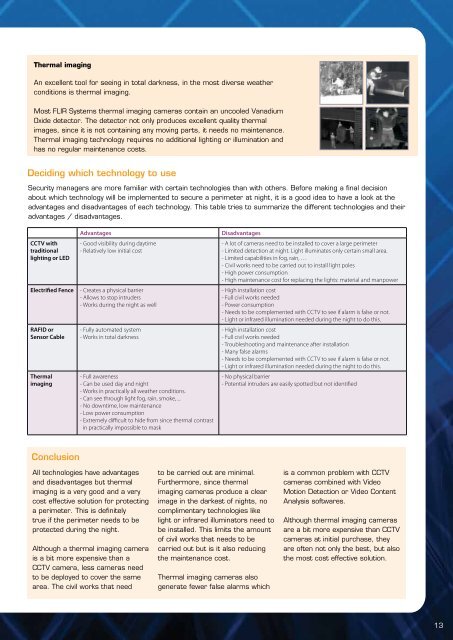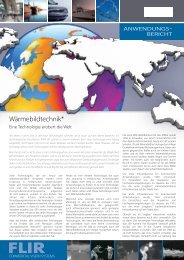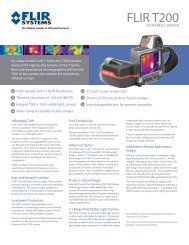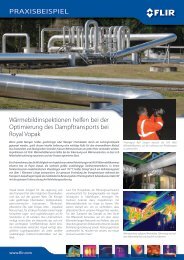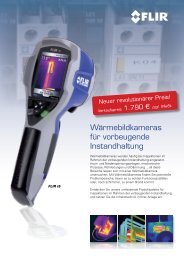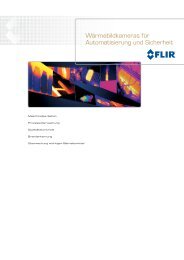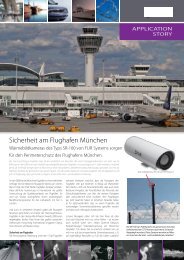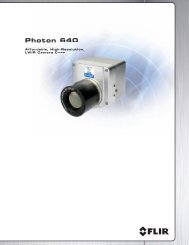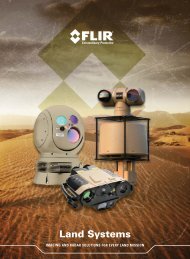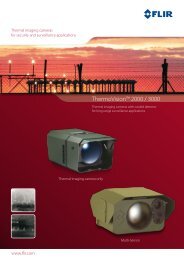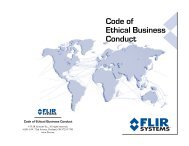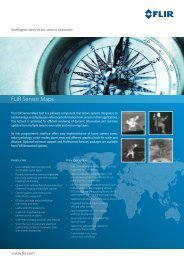Thermal Security Cameras - Flir Systems
Thermal Security Cameras - Flir Systems
Thermal Security Cameras - Flir Systems
You also want an ePaper? Increase the reach of your titles
YUMPU automatically turns print PDFs into web optimized ePapers that Google loves.
<strong>Thermal</strong> imaging<br />
An excellent tool for seeing in total darkness, in the most diverse weather<br />
conditions is thermal imaging.<br />
Most FLIR <strong>Systems</strong> thermal imaging cameras contain an uncooled Vanadium<br />
Oxide detector. The detector not only produces excellent quality thermal<br />
images, since it is not containing any moving parts, it needs no maintenance.<br />
<strong>Thermal</strong> imaging technology requires no additional lighting or illumination and<br />
has no regular maintenance costs.<br />
deciding which technology to use<br />
<strong>Security</strong> managers are more familiar with certain technologies than with others. Before making a final decision<br />
about which technology will be implemented to secure a perimeter at night, it is a good idea to have a look at the<br />
advantages and disadvantages of each technology. This table tries to summarize the different technologies and their<br />
advantages / disadvantages.<br />
CCTV with<br />
traditional<br />
lighting or LED<br />
Advantages Disadvantages<br />
- Good visibility during daytime<br />
- Relatively low initial cost<br />
Electrified Fence - Creates a physical barrier<br />
- Allows to stop intruders<br />
- Works during the night as well<br />
RAFID or<br />
Sensor Cable<br />
<strong>Thermal</strong><br />
imaging<br />
conclusion<br />
- Fully automated system<br />
- Works in total darkness<br />
- Full awareness<br />
- Can be used day and night<br />
- Works in practically all weather conditions.<br />
- Can see through light fog, rain, smoke, ...<br />
- No downtime, low maintenance<br />
- Low power consumption<br />
- Extremely difficult to hide from since thermal contrast<br />
in practically impossible to mask<br />
All technologies have advantages<br />
and disadvantages but thermal<br />
imaging is a very good and a very<br />
cost effective solution for protecting<br />
a perimeter. This is definitely<br />
true if the perimeter needs to be<br />
protected during the night.<br />
Although a thermal imaging camera<br />
is a bit more expensive than a<br />
CCTV camera, less cameras need<br />
to be deployed to cover the same<br />
area. The civil works that need<br />
to be carried out are minimal.<br />
Furthermore, since thermal<br />
imaging cameras produce a clear<br />
image in the darkest of nights, no<br />
complimentary technologies like<br />
light or infrared illuminators need to<br />
be installed. This limits the amount<br />
of civil works that needs to be<br />
carried out but is it also reducing<br />
the maintenance cost.<br />
<strong>Thermal</strong> imaging cameras also<br />
generate fewer false alarms which<br />
- A lot of cameras need to be installed to cover a large perimeter<br />
- Limited detection at night. Light illuminates only certain small area.<br />
- Limited capabilities in fog, rain, …<br />
- Civil works need to be carried out to install light poles<br />
- High power consumption<br />
- High maintenance cost for replacing the lights: material and manpower<br />
- High installation cost<br />
- Full civil works needed<br />
- Power consumption<br />
- Needs to be complemented with CCTV to see if alarm is false or not.<br />
- Light or infrared illumination needed during the night to do this.<br />
- High installation cost<br />
- Full civil works needed<br />
- Troubleshooting and maintenance after installation<br />
- Many false alarms<br />
- Needs to be complemented with CCTV to see if alarm is false or not.<br />
- Light or infrared illumination needed during the night to do this.<br />
- No physical barrier<br />
- Potential intruders are easily spotted but not identified<br />
is a common problem with CCTV<br />
cameras combined with Video<br />
Motion Detection or Video Content<br />
Analysis softwares.<br />
Although thermal imaging cameras<br />
are a bit more expensive than CCTV<br />
cameras at initial purchase, they<br />
are often not only the best, but also<br />
the most cost effective solution.<br />
13


